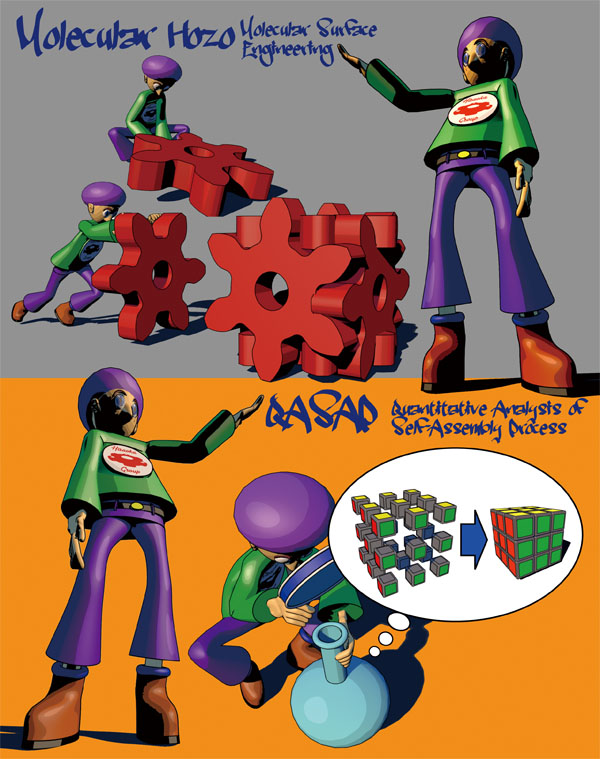Hiraoka group is working on three unsolved issues that remain in molecular self-assembly.

How does molecular self-assembly take place?
Since the discovery of the phenomenon of molecular self-assembly, the mechanism of this phenomenon has remained a mystery for a long time. Our laboratory has been working on this issue since 2014, focussing on coordination self-assemblies, and has developed a unique analysis method called QASAP (Quantitative Analysis of Self-Assembly Process). Then, the formation mechanism of self-assemblies such as capsules, cages, and rings was revealed [Link]. Through our research on the self-assembly processes of coordination assemblies, it was found that many coordination self-assemblies proceed through various pathways, unlike ordinary chemical reactions. QASAP can be used to investigate various molecular self-assembly processes, not limited to coordination self-assemblies. The goal of this project is to elucidate the principles governing molecular self-assembly by revealing the formation mechanism of a variety types of molecular self-assemblies. Only our laboratory in the world is systematically investigating the formation mechanism of coordination self-assemblies, and we are currently using QASAP to collaborate with researchers around the world. We are looking forward to starting new collaborating works with researchers who have originally developed molecular self-assemblies. If you are interested in the self-assembly processes of your system, please contact with us.
Molecular Mortice and Tenon (Molecular “Hozo”): Can we form stable molecular self-assemblies using only weak and less directional Intermolecular Interactions?
The formation of ordered molecular self-assemblies depends on how information about the directionality of intermolecular interactions is incorporated into the building blocks. Some intermolecular interactions, such as van der Waals (vdW) force, have poor directionality and weak attractive force. However, there are examples where vdW force is used efficiently in Nature. In our laboratory, we are trying to form unique molecular self-assemblies with great stability by using weak molecular interactions that lack the direction of chemical bond such as vdW force and the hydrophobic effect. To compensate for the lack of directionality in chemical bonding, we designed an indented molecular surface on the molecules, and we have developed discrete molecular self-assemblies (nanocube) by meshing gear-shaped molecules. This idea is similar to the method known as “mortise and tenon” that engages wood without using nails or adhesives, and is named “molecular hozo” in Japanese. The use of a molecular tenon and tenon has shown that a stable molecular self-assembly can be formed in water even at 150 °C or higher, even though only weak interactions such as the vdW force and cation-π interaction are used. The goal in this research is to establish the principle of designing a molecular mortise and tenon so that a variety types of discrete molecular self-assemblies can be formed by this method.
Development of dissipative molecular self-assembly systems
The phenomenon of molecular self-assembly is essentially under chemical equilibrium, and the state where self-assembly is completed is static. Although molecular self-assembly plays an important role in life systems, molecular self-assemblies themselves are not life systems. Life activity is maintained by taking in energy from the outside and consuming it, creating an energetically unstable state and always trying to escape the equilibrium state. In this way, the metastable self-assembled state is maintained, and the dynamic self-assembled system (dissipated self-assembled system) in which the assembly and disassembly are repeated is relevant to the life system. By artificially constructing such a system, it is thought that understanding of biological systems will be deepened at the molecular level, and it will function as a molecular machine. Recently, we have used thermal energy to transiently create a state away from chemical equilibrium and build a chemical system that enables to interconvert between ordered and disordered states. In the future, we are trying to build more complicated chemical systems using other energy sources.
